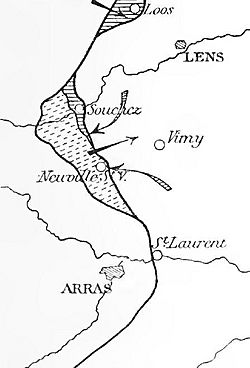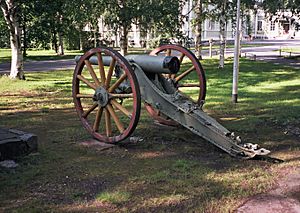Third Battle of Artois facts for kids
Quick facts for kids Third Battle of Artois |
|||||||||
|---|---|---|---|---|---|---|---|---|---|
| Part of the Western Front of the First World War | |||||||||
 Franco-British offensive, September 1915 |
|||||||||
|
|||||||||
| Belligerents | |||||||||
| Commanders and leaders | |||||||||
| Victor d'Urbal John French |
Crown Prince Rupprecht | ||||||||
| Strength | |||||||||
| French Tenth Army: 10 divisions British First Army: 8 divisions |
6th Army: 9 divisions | ||||||||
| Casualties and losses | |||||||||
| French: 48,230 British: 61,713 |
c. 51,100 (2,000 POW) |
||||||||
The Third Battle of Artois was a major fight during the First World War. It took place in Artois, France, from September 25 to November 4, 1915. This battle involved the French Tenth Army and the British First Army fighting against the German 6th Army.
This battle was also known as the Loos–Artois Offensive. It was part of a bigger plan by the French commander, Joseph Joffre. He wanted to use the Allies' larger number of soldiers to push back the German army. The plan included attacks in two different areas: Champagne-Ardenne and Artois. The goal was to capture important railway lines. This would force the Germans to move back from their positions.
Contents
Why the Battle Happened
The French commander, Joffre, had a big plan. He wanted to attack the Germans all along the Western Front. These attacks would be supported by Italian forces and the British army. The British were asked to attack near Loos-en-Gohelle.
At first, British leaders like Field Marshal John French and General Sir Douglas Haig were not sure about the attack. They worried about the difficult land and a lack of powerful cannons and ammunition. However, the British Minister of War, Lord Kitchener, ordered them to go ahead with the offensive.
Getting Ready for Battle
Before the battle, the French Tenth Army gathered a huge force. They had seventeen groups of foot soldiers and two groups of cavalry (soldiers on horseback). They also brought 630 field cannons and 420 heavy artillery pieces.
The German 6th Army had about thirteen groups of soldiers. The French army fired a lot of shells at the German defenses. From September 19 to 13, they fired 1.4 million shells from their field cannons. Their heavy cannons fired another 250,000 rounds. Even older cannons, like the De Bange 90 mm guns, were used to fire 63,500 more shells.
The Battle Begins
The battle started with a massive artillery bombardment on September 21. On September 25, the French Tenth Army attacked at 12:25 p.m. They waited for the morning mist to clear.
Some French groups, like the XXI Corps, made progress. They attacked parts of Souchez village and La Folie farm. The XXXIII Corps also moved forward. However, other groups to the south, the III and XII corps, were pushed back. The 13th Division, part of the XXI Corps, had 14,790 men and lost 41 percent of them in the first few days.
It started raining in the afternoon. This made it hard for the artillery to see their targets. Attack times had to be changed, which made it difficult to work with the British army on their side. By September 26, the French XXXIII and XXI corps had captured Souchez. But the III and XII corps had not moved much south-east of Neuville-St Vaast.
The French army could not break through the second line of German defenses. This meant they could not achieve a major breakthrough. The French commander, Joffre, sent some French soldiers to help the British attacks at Loos. But this did not lead to much success either.
The battle continued in very wet weather. The French Tenth Army managed to capture most of Vimy Ridge. However, the Germans fought back and took the highest point of the ridge from the XXXIII Corps. The battle went on until October 13. It finally ended because of the autumn rains, both sides being very tired, and disagreements between the Allied forces.
After the Battle
Soldier Losses
The battle resulted in many soldiers being injured or killed. German records show that about 51,100 German soldiers were lost by the end of October.
French records show that 48,230 French soldiers were lost. This was less than half of the French losses from a spring battle earlier that year. The British official historian, James Edmonds, reported 61,713 British soldiers and about c. 26,000 German soldiers were lost at the Battle of Loos.
Out of the 48,230 French casualties, 18,657 men were either killed or went missing. The French army also captured about 2,000 German prisoners, 35 machine-guns, and many trench mortars and other equipment.


